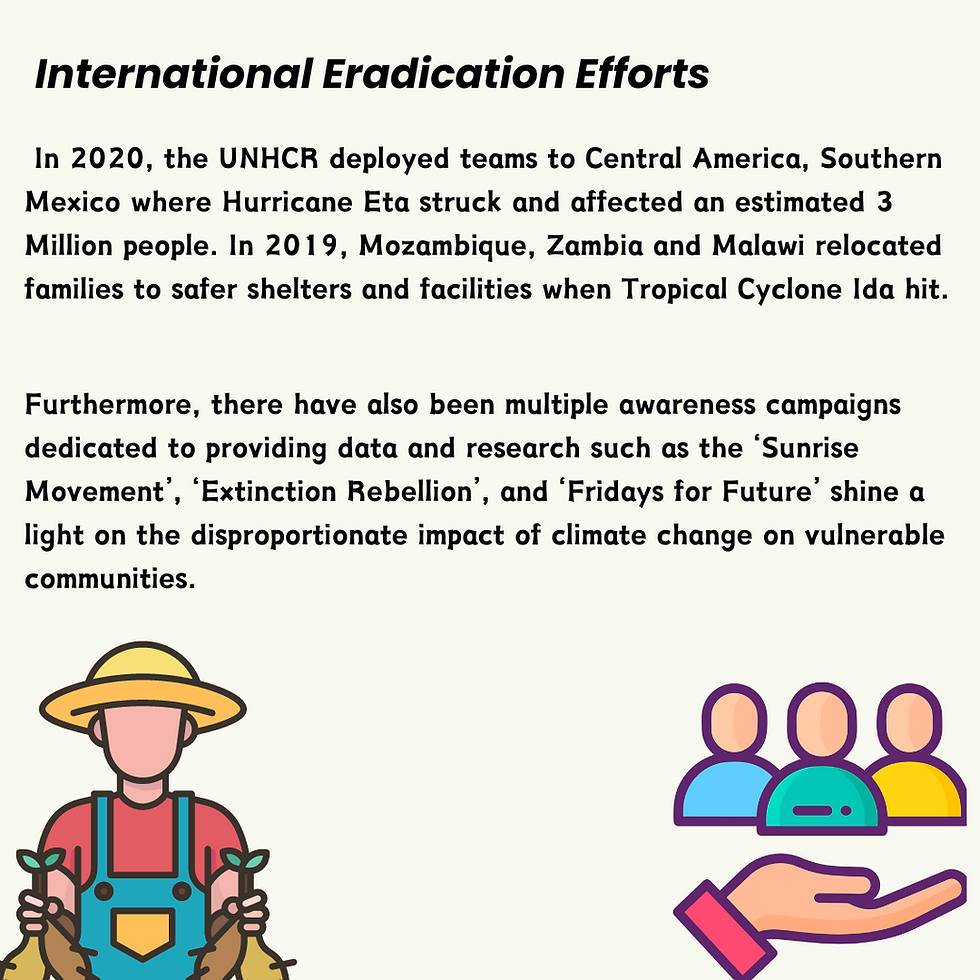Climate Change And Migration Away From Home: A Package Deal
- contactactiveyouth
- May 17, 2024
- 4 min read
Written by Sasha Muraguri
Edited by Othaila Abuzaid and Emil Koch

Climate Displacement, or Migration, refers to the movement of people, permanent or temporary, in the aftermath of the climate-related crises. It can be minimal: between two close regions in the same country, or massive: international relocation.
The Issue At Hand
As the years go by, climate change only becomes this ever-growing beast with numerous rearing heads. In that sense, there are so many different ways that a change in climate and weather can affect unsuspecting people and make their homes unsafe.
For instance, due to climate change, there are rising sea levels, where melting ice caps threaten the livelihood of coastal communities, as well as small island nations, as the melting ice caps could fundamentally change the geography of the land, and, hence, making habitation unsafe and unsustainable.
On the other end of the scale, another consequence of climate change that could affect communities is drought and water scarcity, which force the communities to always be on the lookout for any source of water when the droughts are prolonged. Furthermore, if the region or country is heavily dependent on agriculture, families, including children and elders, have no choice but to exhaust themselves and any remaining energy they may still have to search for water.

Unfortunately, Climate Change does not stop there, as it could even lead to countless natural disasters, such as Heatwaves, Hurricanes, Typhoons, Floods, and more. All of these horrific disasters not only affect locals but also every one of us around the globe, as they could lead to increased migration and displacement.
Presence And Prevalence Of The Issue Over Time

In the course of human history, there have been some significant cases of migration and displacement that can be traced back to Climate change or extreme weather events.
The state of Climate-Related Migration dates back centuries. During the Mediaeval Period of 800 to 1200 AD, populations in the Upper Northern regions, such as Greenland, to name a few, had communities like the Norse migrate due to climate fluctuations. The 1930s saw severe drought in the Great Plains of the United States, leading to the displacement of hundreds of thousands; if we come back to the present, not much has changed. Not too long ago, Australia experienced its 2019 to 2020 bushfire season, and the US experienced its California Wildfires.
Climate-related displacement, as mentioned previously, has a rippling effect. For instance, the implications on governance, warfare, and country relations are staggering. The Syrian Civil War, which started in 2011, has been linked to prolonged drought leading to water scarcity, food insecurity, and ultimately, the displacement of millions of Syrian citizens and a war-torn Syria.
International Eradication Efforts

In Europe, the landscape is messy. Refugees from Afghanistan, where the country has been facing climate-related disasters since 2020, can face immense difficulty in seeking asylum.
For most countries like Switzerland, refugees are encouraged to return back to their home countries, claiming that the worst is over when that is typically not the case. And it's not just Switzerland; other countries, though they may not have incriminating evidence, have unfavorable policies regarding refugees.
While countries in Europe claim they are at maximum capacity with the refugees they are holding, Nigeria and the Philippines are also countries that have residents fleeing from climate-related issues. Thus, in finding difficulty in seeking refuge, the pace of climate refugees only heightens, and the scale of the refugee crisis increases at an alarming rate.
Nonetheless, there have also been some international efforts dedicated to extending a helping hand to fleeing refugees. In 2020, the UNHCR deployed teams to Central America, Southern Mexico, where Hurricane Eta struck and affected an estimated 3 Million people. In 2019, Mozambique, Zambia, and Malawi relocated families to safer shelters and facilities when Tropical Cyclone Ida hit. Many more accounts are performed by dedicated teams, slowing down the pace and scale of climate refugees.
Furthermore, there have also been multiple awareness campaigns dedicated to providing data and research so that we may gain knowledge on the issue and provide our support, such as the Sunrise Movement, Extinction Rebellion, and Fridays for Future, shine a light on the disproportionate impact of climate change on vulnerable communities.
Overall, the issue is far from resolved. As long as Climate Change continues, families will forever have to uproot themselves and flee their homes and their lives. Strenuous efforts are vital in aiding these families and tackling the real issue at hand.
-----------------------------------------------------------------------------------------
References:
UNHCR - The UN Refugee Agency. (n.d.). UNHCR, the UN Refugee Agency | UNHCR. UNHCR. https://www.unhcr.org/. (Accessed on May 8, 2024)
Warner, K. & United Nations University Institute for Environment and Human Security. (2011). Climate Change Induced Displacement: adaptation policy in the context of the UNFCCC climate negotiations. In LEGAL AND PROTECTION POLICY RESEARCH SERIES (PPLA/2011/02). UNITED NATIONS HIGH COMMISSIONER FOR REFUGEES (UNHCR). https://www.unhcr.org/sites/default/files/legacy-pdf/4df9cc309.pdf.
World Migration Report 2024. (n.d.). IOM Publications Platform. https://publications.iom.int/books/world-migration-report-2024. (Accessed on May 8, 2024)
UNHCR UK -. (n.d.). Climate change and disaster displacement | UNHCR UK. UNHCR UK. https://www.unhcr.org/uk/what-we-do/build-better-futures/environment-disasters-and-climate-change/climate-change-and#:~:text=Climate%20change%20is%20the%20defining,resilience%20in%20a%20changing%20climate. (Accessed on May 8, 2024)
Mohamed, E. (2023, September 15). Climate change displacement: ‘One of the defining challenges.’ Al Jazeera. https://www.aljazeera.com/news/2023/9/15/explainer-climate-changes-effects-on-global-migration. (Accessed on May 8, 2024)



